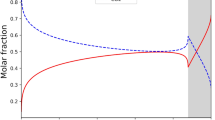Abstract
Three considerations in the rigorous treatment of adsorption data for multicomponent adsorption equilibria are discussed below: (1) choice of pure-component model for the ideal adsorbed solution theory; (2) variable sensitivity analysis for the choice of independent variable sets; and (3) the error-in-variables method for binary interaction parameters. The O’Brien and Myers model gave better agreement with adsorption data than the Langmuir model for single components. However, in the prediction of binary and ternary component adsorption equilibria, IAS theory combined with the O’Brien and Myers model did not show any improvement over the IAS theory with Langmuir model. Sensitivity analysis showed that large sensitivities of dependent variables to independent variables can give large deviations in the prediction of binary component adsorption. This motivated the use of the error-in-variables method, which was shown to be superior to conventional least-squares in calculating the Wilson binary parameters for the prediction of ternary component equilibria with O2-N2-CO adsorption data on zeolite 10X. Smaller deviations in the predictions of total amount of adsorption were found from the parameters regressed by EVM, but the errors in the prediction of mole fraction were not reduced significantly compared to the traditional least squares approach.
Similar content being viewed by others
References
Talu, 0. and Myers, A. L.:AIChE J,34, 1887 (1988).
Kemeny, S. and Manczinger, J.:Chem. Eng. Sci, 33, 71(1978).
Kemeny, S. and Manczinger, J., Skjold-Jorgense, S. and Toth, K.:AIChE J.,28, 20 (1982).
Richter, E., Schutz, W. and Myers, A. L.:Chem. Eng. Sci,44, 1609 (1989).
Ritter, J. A. and Yang, R. T.:I & EC Research,26, 1679 (1987).
High, M. S. and Danner. R. P.:AIChE J.,32. 1138 (1986).
Reilly, P. M. and Patino-Leal, H.:Technometrics,23, 221 (1981).
O’Brien, J. A. and Myers, A. L.:J. Chem. Soc. Faraday Trans.,1, 1467(1984).
O’Brien, J. A. and Myers, A. L.:I & EC Research, 27, 2085 (1988).
Myers, A. L. and Prausnitz, J. M.:AIChE J.,11, 121 (1965).
Suwanayuen, S. and Danner, R. P.:AIChE J.,26, 68 (1980).
Cochran, T. W., Kabel, R. L. and Danner, R. P.:AIChE J.,31, 268 (1985).
Talu, O. and Myers, A. L.:AIChE J,34, 1931 (1988).
Valko, P. and Vajda, S.:Computers Chem. Engng.,11, 37(1987).
Kim, I. W., Liebman, M. J. and Edgar, T. F.:AIChE J.,36, 985 (1990).
Edgar, T. F. and Himmelblau. D. M.: “Optimization of Chemical Processes”, McGraw Hill (1988).
Danner, R. P. and Wenzel, L. A.:AIChE J.,15, 515 (1969).
Cochran, T. W., Kabel, R. L. and Danner, R. P.:AIChE J.,31, 2075(1985).
Dorfman, L. R. and Danner, R. P.:AIChE Symp. Ser.,71, 30 (1975).
Hyun, S. H. and Danner, R. P.:J. Chem. Eng. Data,27, 196 (1982).
Author information
Authors and Affiliations
Rights and permissions
About this article
Cite this article
Kim, IW. Rigorous treatment of adsorption data for multicomponent predictions. Korean J. Chem. Eng. 10, 85–92 (1993). https://doi.org/10.1007/BF02697399
Received:
Accepted:
Issue Date:
DOI: https://doi.org/10.1007/BF02697399




